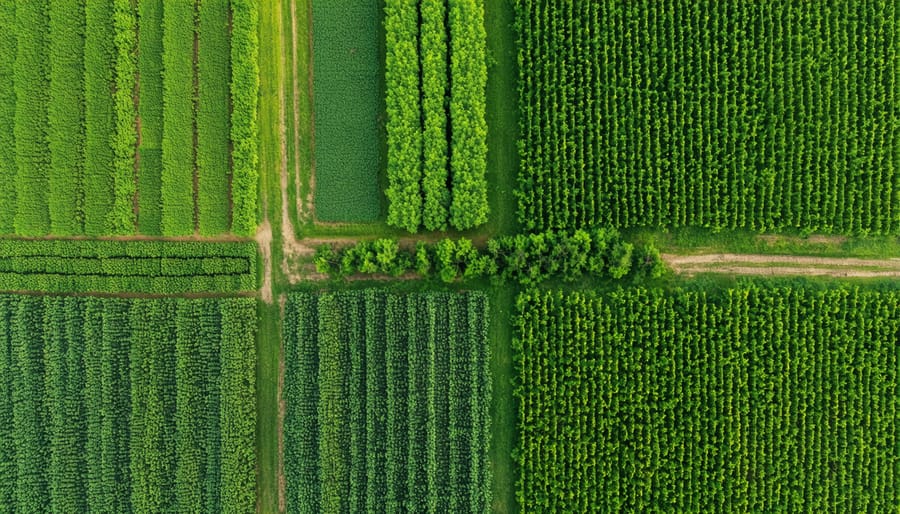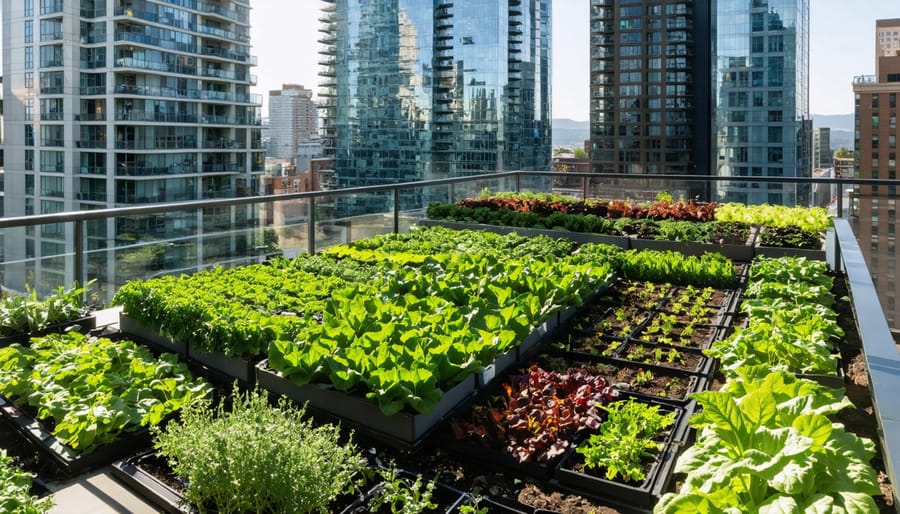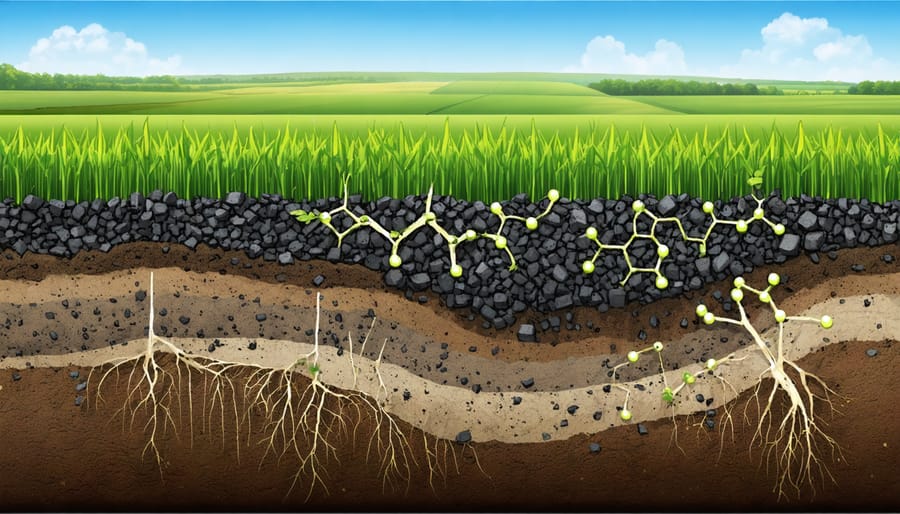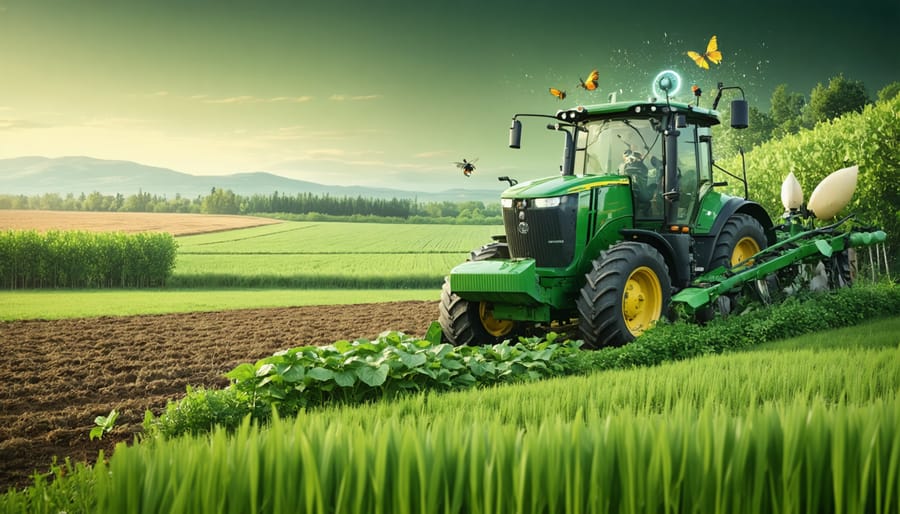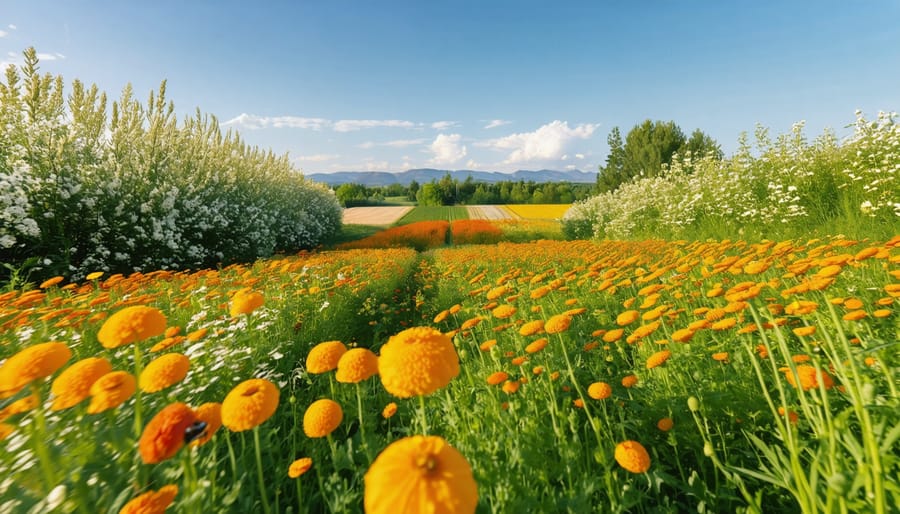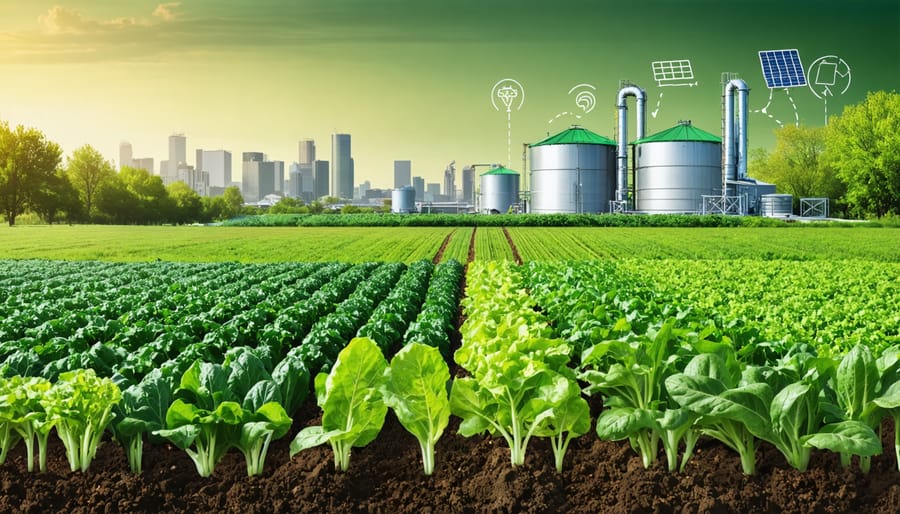Transform your farm’s productivity and environmental impact by integrating trees, crops, and livestock in a strategic agroforestry system. Across Alberta’s diverse landscapes, innovative farmers are discovering how this time-tested practice delivers multiple revenue streams while building climate resilience. From windbreaks that boost crop yields by 20% to silvopasture systems that provide shade for livestock and additional income through sustainable timber harvest, agroforestry represents a powerful shift in Canadian agriculture.
Recent studies from the University of Alberta demonstrate that agroforestry systems sequester up to 10 times more carbon than conventional farming while increasing soil organic matter by 30% over five years. For Alberta farmers facing increasing weather extremes, these living systems offer practical solutions: reducing wind erosion, managing water flow, and creating beneficial microclimates that extend growing seasons.
Beyond environmental benefits, agroforestry delivers compelling economic advantages. Local case studies show diversified income streams from nuts, fruits, timber, and honey production, with some operations reporting 40% higher total farm revenue compared to traditional single-crop systems. This integrated approach not only enhances farm resilience but also positions Canadian agriculture at the forefront of sustainable food production.
Economic Benefits That Make Agroforestry Worth Your Time
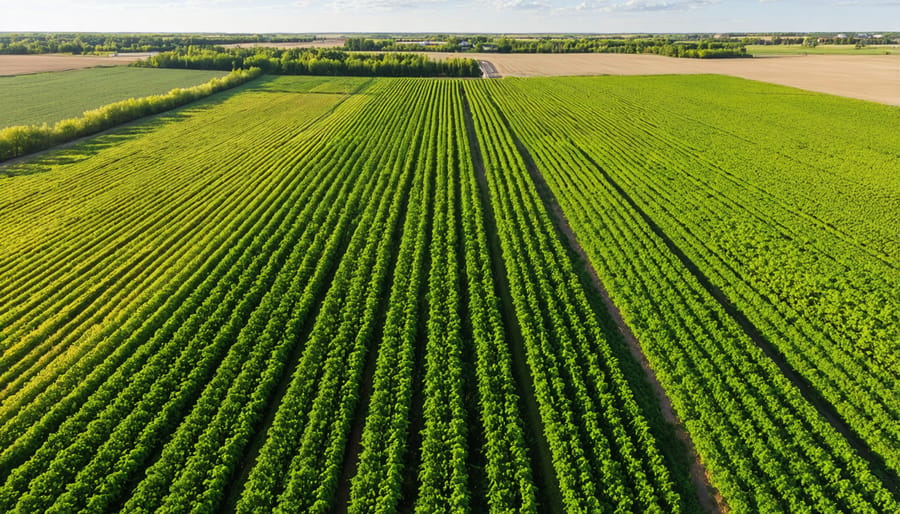
Multiple Income Streams from Single Land Use
One of the most compelling advantages of agroforestry is its ability to generate multiple income streams from the same piece of land. By strategically integrating trees with traditional crops or livestock, Alberta farmers can significantly diversify their revenue sources while optimizing land use.
Consider a typical quarter section where you might grow canola or wheat. By incorporating rows of fruit or nut trees, you maintain your primary crop production while adding new marketable products. For example, saskatoon berries, which thrive in our climate, can generate $15,000-$20,000 per hectare once established, while still allowing for forage or grain production between tree rows.
Trees themselves offer various income opportunities. Depending on species selection, you could harvest nuts, fruit, syrup, or timber. Fast-growing hybrid poplars can be harvested for pulpwood in 15-20 years, while slower-growing hardwoods like maple or oak become valuable timber assets for future generations.
The understory presents additional opportunities. Shade-tolerant crops like ginseng or mushrooms can thrive beneath the canopy, providing supplementary income during tree maturation. Many Alberta farmers have successfully incorporated bee operations within their agroforestry systems, benefiting from both honey production and improved pollination of their primary crops.
This layered approach to farming not only spreads financial risk across multiple products but also provides income throughout different seasons, creating a more stable and resilient business model.
Reducing Input Costs Through Natural Systems
Integrating trees and shrubs into your farming system can significantly reduce input costs while maintaining or even improving productivity. Here in Alberta, farmers are discovering that agroforestry naturally supports essential farming functions, leading to substantial savings on operational expenses.
Properly planned tree systems act as natural fertilizer factories, particularly when incorporating nitrogen-fixing species like sea buckthorn or buffaloberry. These plants enhance soil fertility by fixing atmospheric nitrogen, reducing the need for synthetic fertilizers. Many Alberta farmers report cutting their fertilizer costs by 15-30% after establishing agroforestry systems.
Strategic tree placement also creates natural pest management zones. Birds and beneficial insects that make their homes in these areas help control crop pests naturally. Dave Thompson, a farmer near Red Deer, shares that he’s reduced pesticide applications by nearly 40% since incorporating shelterbelts around his fields five years ago.
When it comes to irrigation, trees and shrubs help retain soil moisture through reduced wind speed and increased organic matter content. The root systems improve water infiltration and storage capacity, while the canopy provides shade that reduces evaporation. During Alberta’s dry spells, farms with established agroforestry systems typically require less supplemental irrigation, with some reporting water savings of up to 25%.
These natural systems may take time to establish, but the long-term reduction in input costs makes them a worthwhile investment for forward-thinking farmers.
Environmental Advantages for Your Farm
Soil Health Enhancement
Trees are nature’s soil engineers, working tirelessly to revitalize your land through multiple processes. Here in Alberta, where soil degradation can be a significant concern, incorporating trees into farming systems has shown remarkable results in improving soil health.
The deep-reaching root systems of trees create natural channels for water infiltration and soil aeration. These channels help break up compacted soil layers, allowing better root development for crops and enhanced water retention. During our prairie winters, these root networks also help prevent soil erosion, particularly in areas prone to spring runoff.
Trees contribute to soil fertility through their annual leaf litter and continuous root turnover. This organic matter decomposition enriches the soil with essential nutrients and helps maintain optimal pH levels. Many Alberta farmers have reported reduced fertilizer needs in areas where trees have been established for several years.
Perhaps most importantly, trees create microhabitats that support thriving soil biodiversity. The shade and shelter they provide create ideal conditions for beneficial organisms like earthworms, fungi, and bacteria. These organisms break down organic matter, cycle nutrients, and form stable soil aggregates that improve overall soil structure.
In shelterbelts and silvopasture systems across the province, farmers have observed increased organic matter content, better moisture retention, and reduced wind erosion. This improvement in soil health typically becomes noticeable within 3-5 years of tree establishment, with benefits continuing to accumulate over time. The key is selecting tree species well-adapted to local conditions and positioning them strategically within your agricultural system.

Climate Resilience in Alberta
Alberta’s farming landscape faces unique climate challenges, from unpredictable frost patterns to severe drought conditions. Agroforestry systems offer robust climate solutions for Alberta farmers, providing essential protection against extreme weather events while building long-term resilience.
Strategic tree placement creates effective windbreaks that reduce soil erosion and protect crops from damaging winds, particularly during the critical spring planting season. These shelterbelts can decrease wind speeds by up to 80% within protected zones, significantly reducing moisture loss and protecting young plants.
During intense summer heat, agroforestry systems help maintain more stable soil temperatures and humidity levels. The tree canopy provides essential shade, reducing heat stress on livestock and protecting sensitive crops. This natural climate control can extend the growing season and improve crop quality, especially for heat-sensitive varieties.
In winter months, strategically placed trees capture and distribute snow more evenly across fields, improving soil moisture retention for spring planting. This natural snow management system can increase available spring moisture by up to 30% compared to open fields.
Local success stories demonstrate these benefits in action. The Henderson family farm near Red Deer reported a 25% increase in soil moisture retention after implementing silvopasture practices, while maintaining consistent forage production during recent drought years. Their integrated system includes hybrid poplars and native spruce, creating year-round protection for their cattle operation.
By incorporating trees and shrubs into agricultural landscapes, Alberta farmers are building natural infrastructure that helps buffer against climate extremes while enhancing overall farm productivity and sustainability.
Practical Implementation Success Stories
The Thompson Family’s Windbreak Revolution
When Rob and Sarah Thompson purchased their 640-acre farm near Olds, Alberta, in 2008, they faced a familiar challenge: relentless prairie winds that damaged crops and eroded valuable topsoil. Today, their property stands as a testament to the transformative power of well-planned windbreaks.
“We lost about 15% of our canola crop in the first year due to wind damage,” recalls Rob. “That’s when we knew we needed to make a change.” Working with local agroforestry specialists, the Thompsons developed a comprehensive windbreak system using a mix of white spruce, caragana, and green ash.
The results have exceeded their expectations. Within five years of establishing their windbreaks, the Thompsons documented a 20% reduction in wind velocity across their fields. This protection led to measurable improvements in crop yields, with wheat production increasing by 12% and canola yields rising by 18% in protected areas.
But the benefits extended beyond crop protection. The windbreaks created new habitat for beneficial insects and birds, naturally supporting pest control. Snow capture and distribution improved significantly, providing better moisture retention during spring thaw. The Thompsons estimate they save approximately 40,000 litres of irrigation water annually due to reduced evaporation.
“The initial investment was about $15,000, including planning and installation,” Sarah explains. “We recovered those costs within three years through improved yields alone.” The family also reports significant savings on fuel costs, as their equipment now operates more efficiently in the calmer conditions.
The Thompsons regularly host field days for neighbouring farmers, sharing their experience and data. “It’s not just about the numbers,” Rob emphasizes. “There’s something deeply satisfying about working with nature instead of against it. Our farm feels more resilient, more sustainable.”
Their success has inspired twelve other local farms to implement similar systems, creating a growing network of windbreak-protected properties in the region.
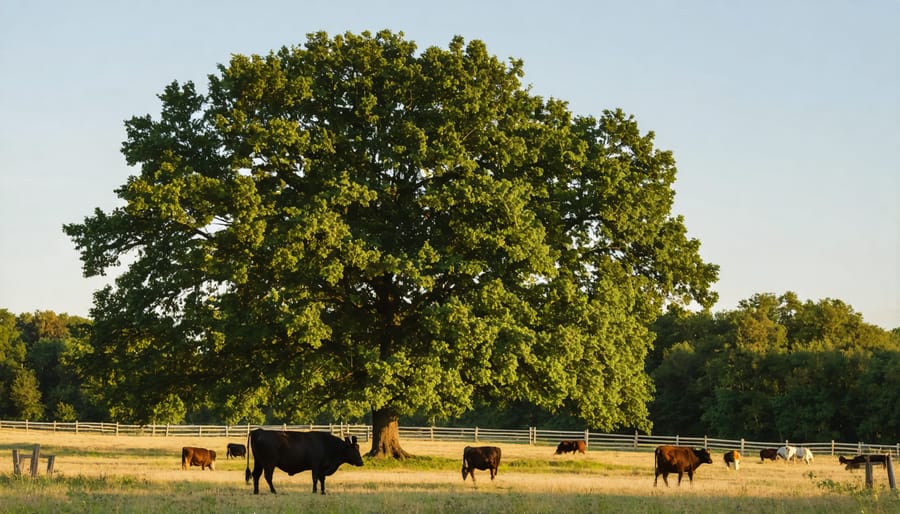
Silvopasture Success at Prairie Ridge Farm
Located just outside of Red Deer, Alberta, Prairie Ridge Farm has become a shining example of successful silvopasture implementation. Owner Sarah McKenzie transitioned her traditional cattle operation to include strategic tree integration five years ago, demonstrating how sustainable livestock practices can transform a farm’s productivity.
McKenzie’s 160-hectare operation now features rows of hybrid poplar and white spruce interspersed throughout grazing paddocks. The trees provide shelter for her herd of 120 Black Angus cattle, while also creating additional revenue streams through future timber production and carbon credits.
“The change in cattle behavior was almost immediate,” McKenzie notes. “During extreme weather, both hot and cold, the animals naturally seek shelter among the trees. We’ve seen reduced stress levels and improved weight gain compared to our previous open-pasture system.”
The farm’s data shows impressive results: a 15% reduction in winter feed costs due to decreased wind chill, a 20% improvement in soil moisture retention, and noticeably better grass growth in sheltered areas. The tree rows, planted 25 metres apart, allow for efficient rotational grazing while maximizing the benefits of shade and wind protection.
McKenzie’s approach includes seasonal adjustments to maximize the silvopasture benefits. During spring calving, the sheltered areas provide crucial protection for newborns. In summer, the shade from established trees helps maintain grass quality longer into the dry season. Winter brings additional advantages as the windbreak effect reduces energy requirements for the herd by up to 25%.
The success at Prairie Ridge Farm hasn’t gone unnoticed. Local agricultural extension services now use the operation as a demonstration site, helping other Alberta farmers understand the practical implementation of silvopasture systems. McKenzie regularly hosts field days, sharing her experiences and helping others learn from both her successes and initial challenges.
As we’ve explored throughout this article, agroforestry offers transformative benefits for Canadian farmers, combining traditional agricultural wisdom with modern sustainable practices. The integration of trees and shrubs into farming operations has demonstrated remarkable results across Alberta and beyond, from increased soil fertility and improved water management to enhanced biodiversity and additional revenue streams.
The evidence is compelling: farms implementing agroforestry systems have reported up to 30% increase in soil organic matter, significant reduction in wind erosion, and improved crop yields in sheltered areas. Many Alberta farmers have successfully diversified their income through timber production, fruit harvesting, and carbon credit programs while strengthening their farm’s resilience against climate challenges.
But perhaps most importantly, agroforestry represents a path forward that aligns with our values as Canadian farmers – stewardship of the land, sustainable production, and building legacy operations for future generations. The success stories we’ve shared from local farmers demonstrate that these benefits are not just theoretical but achievable right here in our province.
Taking the first step toward implementing agroforestry doesn’t have to be overwhelming. Start small by identifying areas where windbreaks could benefit your operation, or consider incorporating fruit trees into unused field margins. Local agricultural extension offices and experienced agroforestry practitioners are ready to support your journey with practical advice and resources.
The time to act is now. As our agricultural landscape evolves with changing climate patterns and market demands, agroforestry offers a proven strategy for building resilient, profitable farms. Connect with your local agricultural association, reach out to neighboring farms practicing agroforestry, and explore available government support programs for implementation.
Remember, every tree planted and every hectare converted to agroforestry practices contributes to a more sustainable future for Canadian agriculture. Your decision to embrace agroforestry isn’t just an investment in your farm – it’s an investment in our collective agricultural heritage and future prosperity.

